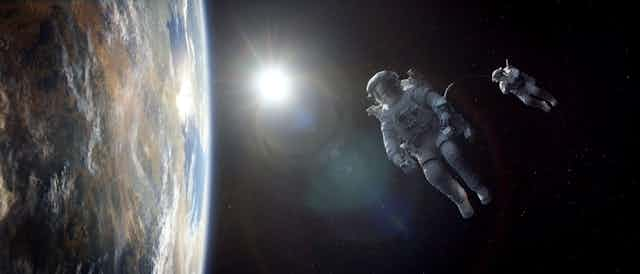Cinema’s relationship to gravity is a fascinating one.
At the time of its birth, in 1895, cinema was seen as a revolutionary machine that didn’t simply defy gravity through moving pictures seemingly suspended in air, but allowed one to experience the forces of the world directly, sweetly, intimately.
The stories of the first movie patrons hurrying away from the screen in case they were run over as The Train Arrived at the Station (The Lumière Brothers, 1896) flickered before them is a startling – if perhaps mythical – account of cinema’s gravitational grandeur.
The awe and wonder of cinema lies in its remarkable ability to visualise and texturise the weight and feel of things, to render movement and velocity realistically, and to create spaces deep, far and wide. The precipice is one of cinema’s favourite environments. Directors turn to it to create a sense of depth and distance, and to enact the experience of falling.
An iconic cinematic moment, captured in such films as Vertigo (Hitchcock, 1958) and Strange Days (Bigelow, 1995), involves a character looking down from the precipice, to then either jump, fall or be pushed off the edge, with a corresponding cinematography that captures them hurtling, hurtling, hurtling towards the nadir. Then splat.
The power and beauty of cinema in part resides in its ability to effectively engage the viewer’s emotions, and to envelop the body in a sea of sensations that are directly felt. Cinema is a sentient machine that awakens the senses in all of us.
Cinema can create the conditions for viewers to sweat, feel nauseous, or be aroused. In action sequences or scenes of terror, it can lead to an increase in viewers’ heart-rates and make their pupils dilate.
At its most awesome, when we are faced by something extraordinary or perplexing, cinema can take our breath away, render us speechless and powerless before its infinite gaze. Many critics argue that the Star Gate sequence in 2001: A Space Odyssey (Kubrick, 1968) is one such sublime moment. The viewer is taken along an unknown colourised vector, without “narrative” coordinates to anchor them, enabling them to experience the existential nothingness of (anti) gravity as they do so.
Science fiction cinema is particularly suited to capturing the sensorial qualities of movement and speed. Its special effects and future settings enable it to legitimately defy gravity; to take the viewer through incandescent wormholes at light speed and out into alien environments where objects, spaces, things don’t follow gravitational laws or the iron cage of physics.
The expansive space of science fiction creates the sense that gravity is a minor factor in the workings of the universe. When these films are set in outer space, science fiction is able to demonstrate the giddiness of weightlessness, the eerie silence of dark space, and the absolute terror of being untethered from Earth.
Gravity (Cuarón, 2013) is perhaps one of the most perfect demonstrations of cinema’s intimate and inter-connecting relationship to the forces of nature and the forces that lie beyond them, nestled as they are amongst the vast, undulating sheets of the cosmos.
The film’s unbroken opening “floating” shot, lasting more than 13 minutes, captures the weightlessness and the spinning vastness of space, the distant, rotating beauty of Earth, and humankind’s sense of isolation and isolating melancholy as the astronauts go about their daily, routinised work, as if they have clocked in at an inter-stellar factory.
Gravity’s 3D spatial arrangements induce a sense of vertigo, disorientating the viewer, creating the sensation that one is in outer space, beholden by its massiveness, and yet trapped precisely because one is not tethered to anything. Debris shoots out from the darkness; lines dangle; space is not logical. There is zero gravity in Gravity.
There is no single or singular precipice in the film: the mise-en-scène combines zenith and nadir. One is constantly falling or climbing, climbing and falling. It is difficult to breathe while watching the movie, and almost impossible to not experience one’s own body as if it is stranded in outer space, without gravitational crampons to hold onto, to root one to terra firma.
If newspaper reports are accurate, then just as the train that arrived at the station created hysteria in those who watched it more than 100 years ago, so today Gravity sends people running down the aisles, too discombobulated to carry on watching.
Much of contemporary blockbuster cinema functions simply to activate the senses; to enact and embody the “thrill aesthetic” through its lavish special effects and immersive 3D technology.
There is much criticism of this as a cinematic form. Some argue that complex characterisation and serious storytelling are marginalised or juvenilised in favour of the kinetic ride.
Thrill, however, is an expansive concept and the senses are not necessarily crude or divisible in the way. Spectacle can create the conditions for profound contemplation, as Gravity clearly does.
Gravity releases the viewer into an unknown or unknowable void and in so doing asks, or rather compels, them to consider what it is that makes one human, social, and connected.
Lost in space, caught floating and fleeing in the pure realm of the senses, we find out who we truly are and can be.
See further Oscars 2014 coverage on The Conversation.

